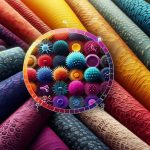You might wonder why antimicrobial fabrics are gaining attention in various industries. These textiles can greatly improve hygiene by reducing harmful microorganisms, making them ideal for healthcare and daily use. Imagine not having to worry about unpleasant odors or frequent washes, thanks to their ability to inhibit bacterial growth. But that's just the beginning; their durability and cost-efficiency add even more value. Curious about how these fabrics are revolutionizing fashion and promoting sustainability? There's much more to uncover about their versatile applications and long-term benefits.
Table of Contents
Key Takeaways
- Enhanced Hygiene: Antimicrobial fabrics inhibit the growth of harmful microorganisms, improving overall cleanliness.
- Odor Control: These fabrics prevent bacteria growth, effectively reducing unpleasant odors and enhancing comfort.
- Durability: Antimicrobial fabrics maintain effectiveness and integrity through repeated use and washing, ensuring long-lasting durability.
- Environmental Benefits: Reduced need for frequent washing conserves water and minimizes microplastic release, promoting eco-friendly practices.
- Versatile Applications: They are useful in fashion, activewear, and healthcare, enhancing hygiene, safety, and longevity across various industries.
Enhanced Hygiene and Safety
Antimicrobial fabrics greatly enhance hygiene by actively reducing the presence of harmful microorganisms. By incorporating these fabrics into your daily life, you can benefit from increased protection against a variety of bacteria and viruses. These fabrics are designed to disrupt the growth and spread of pathogens, providing a safer and cleaner environment for you.
You'll appreciate how antimicrobial fabrics contribute to improved cleanliness. Traditional materials can harbor bacteria, leading to potential health risks. However, antimicrobial fabrics are treated with agents that inhibit microbial activity, ensuring that surfaces and clothing stay fresher for longer periods. This means fewer wash cycles are needed, saving you time and resources while maintaining a higher standard of hygiene.
Incorporating antimicrobial fabrics into your wardrobe or home not only enhances personal safety but also promotes a cleaner living space. You'll experience peace of mind knowing that these innovative materials are actively working to reduce microbial contamination.
Whether for medical settings, athletic wear, or everyday use, antimicrobial fabrics provide an essential layer of protection, ensuring that your environment remains as hygienic as possible.
Embrace the benefits of these advanced materials and take your cleanliness to the next level.
Odor Control
You'll love how these fabrics actively combat unpleasant odors, keeping your clothes and surroundings smelling fresh. Antimicrobial fabrics work by incorporating advanced technologies that target bacteria prevention, the primary cause of bad smells.
As you go about your day, bacteria thrive on sweat and skin oils, breaking them down and causing odor. These smart textiles disrupt that process, ensuring improved freshness throughout your activities.
Imagine working out or enduring a long, busy day without worrying about unpleasant smells. These fabrics excel in sweat absorption, capturing moisture efficiently and reducing the environment where bacteria can grow.
By managing moisture, they not only minimize odor but also enhance your overall comfort.
Incorporating antimicrobial fabrics into your daily wear or home textiles isn't just about avoiding bad smells—it's about maintaining a higher standard of cleanliness and hygiene.
With effective odor reduction, you'll feel more confident and at ease, no matter the situation.
From athletic wear to everyday clothing and even bedding, these innovative fabrics provide a practical solution for a fresher, more pleasant experience.
Embrace the benefits of antimicrobial fabrics and enjoy a new level of odor control that aligns with your quest for mastery.
Durability and Longevity
While enjoying the benefits of odor control, you'll also appreciate how these fabrics are designed to withstand repeated use and washing without losing their effectiveness. Antimicrobial fabrics boast a remarkable durability that ensures long-term performance. Unlike regular materials that degrade over time, these fabrics maintain their integrity through numerous laundering cycles, making them a wise choice for the discerning user.
You'll find that the longevity of antimicrobial fabrics directly translates to cost efficiency. Since they last longer, you won't need to replace them as often, saving you money in the long term. This durability means you're not just investing in a product but in a lasting solution that stands the test of time.
Moreover, the easy maintenance of antimicrobial fabrics adds to their appeal. Routine washing is all that's needed to keep them in top condition, eliminating the need for special cleaning treatments or frequent replacements. This ease of care complements a busy lifestyle, allowing you to focus on what truly matters without worrying about fabric upkeep.
Essentially, antimicrobial fabrics combine durability, cost efficiency, and easy maintenance, offering you a superior choice for both everyday and specialized needs.
Versatile Applications
Thanks to their unique properties, antimicrobial fabrics find applications across a wide range of industries and everyday uses. In the fashion industry, these fabrics are revolutionizing how we think about clothing hygiene and longevity. Imagine wearing activewear that resists odor even after intense workouts or casual wear that maintains freshness throughout a busy day.
In the healthcare sector, antimicrobial fabrics play a pivotal role in enhancing patient care and safety. Hospital linens, scrubs, and patient gowns crafted from these materials can significantly reduce the spread of infections. This is especially essential in environments where hygiene is paramount.
Here's a quick comparison to illustrate the diverse applications of antimicrobial fabrics:
| Industry | Application | Benefits |
|---|---|---|
| Fashion Industry | Activewear | Odor resistance, increased durability |
| Fashion Industry | Casual wear | Maintains freshness |
| Healthcare Sector | Hospital linens | Reduces infection spread |
| Healthcare Sector | Scrubs and patient gowns | Enhances hygiene and safety |
Environmental Benefits
Antimicrobial fabrics offer significant environmental benefits by reducing the need for frequent washing and harsh chemical treatments. When you use these advanced textiles, you extend the life of your garments and household items. Less frequent laundering not only conserves water but also minimizes the release of microplastics into the environment. By cutting down on the use of detergents and fabric softeners, you further reduce the chemical load entering our waterways.
Furthermore, antimicrobial fabrics contribute to reduced waste by maintaining their integrity and effectiveness over extended periods. Traditional fabrics often require replacement due to wear and tear or persistent odors. However, antimicrobial properties help fabrics resist these issues, meaning you won't need to replace your items as often. This longevity directly supports sustainable practices by reducing the volume of waste that ends up in landfills.
In addition, the manufacturing process for antimicrobial fabrics increasingly incorporates sustainable practices. Many companies are now focusing on eco-friendly production methods, such as using organic fibers and non-toxic dyes. By choosing antimicrobial fabrics, you're not just investing in high-performance textiles; you're also supporting a more sustainable and environmentally-friendly industry.
Frequently Asked Questions
How Do Antimicrobial Fabrics Compare in Cost to Regular Fabrics?
When comparing costs, antimicrobial fabrics are generally more expensive than regular ones. However, their durability advantages mean you'll replace them less often, potentially saving money in the long run. Consider both cost comparison and longevity in your decision.
Are Antimicrobial Fabrics Safe for Individuals With Sensitive Skin?
Imagine wrapping yourself in a cloud. Antimicrobial fabrics are typically safe for sensitive skin, reducing skin reactions and allergies. They're designed for comfort and breathability, ensuring you stay irritation-free while enjoying their protective benefits.
Can Antimicrobial Treatments Be Applied to Existing Fabrics?
You can apply antimicrobial treatments to existing fabrics. This enhances fabric preservation and boosts fabric reusability, making your textiles last longer and stay fresher. Mastering this technique guarantees your fabrics remain in top condition.
What Types of Microorganisms Can Antimicrobial Fabrics Effectively Combat?
Antimicrobial fabrics are a miracle against bacterial resistance and fungal growth. They excel in odor control and moisture-wicking, making them a must-have for those seeking mastery in hygiene and comfort. They combat bacteria, fungi, and viruses effectively.
How Do Washing and Drying Affect the Efficacy of Antimicrobial Fabrics?
Repeated washing can reduce the efficacy of antimicrobial fabrics, but the impact of sunlight during drying can help maintain their properties. To master care, follow manufacturer guidelines to preserve antimicrobial effectiveness over time.
- Tetron Fabric for Marine Applications: Durability and Use Cases - June 18, 2025
- Tetron Fabric for Outdoor Furniture: Weather Resistance and Care - June 18, 2025
- Tetron Fabric for Wall Coverings: Style and Application Tips - June 18, 2025







